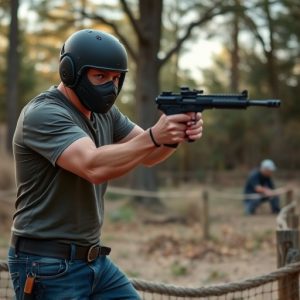Non-lethal Stun Guns: Optimal Electrode Spacing for Seniors’ Safety
Non-lethal self-defense weapons, particularly stun guns, are gaining popularity among seniors seekin…….
Non-lethal self-defense weapons, particularly stun guns, are gaining popularity among seniors seeking protection without fatal risks. These devices use electric current to temporarily disable assailants, aiding seniors with reduced mobility or strength. Stun guns' effectiveness lies in their electrode spacing, which controls energy distribution and impact. Proper training and safe usage practices are vital for optimal results. When selecting non-lethal self-defense weapons for seniors, focus on devices that balance power and safety, ease of use, and portability to ensure reliable personal protection without compromising independence.
In today’s world, older adults often require specialized protection, making non-lethal self-defense weapons an appealing option. This article explores the critical aspect of stun gun electrode spacing and its impact on effectiveness. We delve into the science behind these devices, focusing on how electrode placement influences their performance. Understanding this feature is essential when choosing tools for seniors’ safety, ensuring they have options tailored to their needs without compromising power.
- Understanding Non-lethal Self-Defense Weapons for Seniors
- The Role of Electrode Spacing in Stun Guns
- Effectiveness and Safety Considerations
- Choosing the Right Stun Gun for Seniors' Protection
Understanding Non-lethal Self-Defense Weapons for Seniors
Non-lethal self-defense weapons, like stun guns, have gained popularity among seniors looking to protect themselves. These devices use an electric current to disable an assailant temporarily, providing enough time for escape or help. For seniors, who might have reduced mobility or strength, a stun gun offers a discreet and effective solution without the risk of fatal injury.
Understanding how these weapons work and their effectiveness is crucial. Stun guns deliver a strong electric shock through electrodes that make contact with an attacker’s body. The current disrupts muscle control, causing the person to fall to the ground and become temporarily paralyzed. This technology has been proven effective in various scenarios, especially for seniors who can use them with ease, given their lightweight design and simple activation mechanisms. Proper training on usage and safety measures is essential for optimal effectiveness and minimal risk.
The Role of Electrode Spacing in Stun Guns
The electrode spacing in stun guns plays a pivotal role in their effectiveness, especially when considering non-lethal self-defense weapons designed for seniors or individuals seeking safe personal protection. This aspect is crucial as it determines the energy distribution and the overall impact of the device. Stun guns with well-designed electrodes are more likely to deliver a powerful yet controlled shock, ensuring the user’s safety while neutralizing an assailant.
In stun guns, electrode spacing refers to the distance between the positive and negative electrodes, which is typically measured in millimeters. A closer spacing allows for a more concentrated electric field, resulting in a faster and more intense stun effect. This is particularly beneficial for non-lethal weapons as it enables seniors or users with reduced physical capabilities to disable an attacker swiftly, providing them with an effective means of self-defense.
Effectiveness and Safety Considerations
The effectiveness of a stun gun largely depends on its electrode spacing, which determines the device’s ability to deliver a powerful electric shock. For non-lethal self-defense weapons designed for seniors or individuals seeking safe protection, optimal electrode placement and spacing are crucial. Properly spaced electrodes ensure that the current flows evenly through the target, maximizing disruption without causing severe harm.
Safety considerations play an equally vital role in the design of such devices. Electrode arrangement should be carefully engineered to prevent accidental shocks and minimize the risk of injury. In addition, users must be trained on proper usage to guarantee effective deployment without unintended consequences. This is especially important for vulnerable populations like seniors, ensuring they can defend themselves while maintaining their safety and well-being.
Choosing the Right Stun Gun for Seniors' Protection
When considering non-lethal self-defense weapons for seniors, it’s crucial to focus on devices that offer a balance between effectiveness and safety. Stun guns, also known as electric shock weapons, come in various models with different electrode spacing designs. For elderly individuals looking to protect themselves, a stun gun with larger electrode spacing is often the better choice. These electrodes deliver a stronger electrical current over a wider area, ensuring that even if an attacker has a firm grip on the victim, the shock can still be potent enough to disable them.
The right stun gun should also prioritize ease of use for seniors who might have reduced mobility or strength. Simple activation mechanisms, like a single-click design, allow users to deploy the device quickly and efficiently. Additionally, portability is essential; lightweight and compact stun guns can easily fit in pockets or purses, providing constant peace of mind without being cumbersome. Choosing a stun gun tailored to these needs ensures that seniors have a reliable tool for personal safety while maintaining their independence.
When selecting a non-lethal self-defense weapon for seniors, understanding the role of electrode spacing in stun guns is crucial. The optimal electrode spacing ensures maximum effectiveness and safety, allowing users to defend themselves with confidence. By considering the right stun gun tailored to their needs, seniors can leverage modern technology for enhanced personal security without resorting to lethal force. Remember that choosing the appropriate device plays a vital role in ensuring peace of mind and the ability to navigate potentially dangerous situations with dignity and protection.


